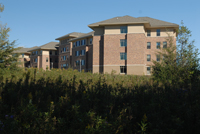UNIVERSITY OF WISCONSIN River Falls
History of Buildings and Areas
George R. Field South Fork Suites

The George R. Field South Fork Suites anchors our East Area residence halls and houses 240 students. There are basketball and tennis courts nearby and the South Fork of the Kinnickinnic River runs behind the building.
South Fork Suites, built in 2004-2005, was named after George R. Field, who was the last President and first Chancellor, serving UWRF from 1968-1985. Born in La Crosse, Wisconsin, in 1929, George R. Field had early ties to River Falls. Both parents, along with several aunts and uncles, had attended the school here.
His father was a guard on the 1923 state champion basketball team. Field earned a bachelor’s degree in geography from Carleton College prior to serving a stint in the U.S. Army from 1951-53. From there he obtained a master’s in educational administration from the University of Colorado and a doctorate from the University of Wisconsin in Madison.
Field taught junior high and served as a school principal before entering higher education administration at the University of Wisconsin. His last position there, immediately prior to accepting the presidency at River Falls, was Vice President for University Development and State Relations for the state university system.
At his inauguration into office on Oct. 8, 1968, President Field noted that “if the battle for greatness at River Falls is to end in victory as did the battle for survival, there must be continued response to challenges, continued revolution if you will. One phase of this revolution must be an ever greater emphasis on the role of the state universities as the ‘People’s Universities.’ As we look forward to the next century, Wisconsin State University-River Falls has a single mission. In its own way, it wants to change the world, too.”
 During his tenure, President Field handled the merger of this campus with the University of Wisconsin System. The merger created one Board of Regents to oversee all of Wisconsin’s public universities and established the set of administrative procedures that govern UW-River Falls down to the present. With the merger, the president’s title was officially changed to Chancellor.
During his tenure, President Field handled the merger of this campus with the University of Wisconsin System. The merger created one Board of Regents to oversee all of Wisconsin’s public universities and established the set of administrative procedures that govern UW-River Falls down to the present. With the merger, the president’s title was officially changed to Chancellor.
Chancellor Field strengthened the shared governance decision-making structure of the university. He brought the Faculty Senate, the Student Senate, and later the Academic Staff Council into the policy-making process. During his tenure the enrollment grew from under 4,000 to nearly 5,500 students, although there were fluctuations over those 17 years that produced budget-tightening and a reduction in staff. He also oversaw the construction of Rodli Commons, Hunt Arena, Kleinpell Fine Arts Building, Centennial Science Hall, and numerous other construction projects.
During the early span of Chancellor Field’s administration, student unrest gripped the campus. Student activism centered on a number of issues, some of them national in scope, while others involved local campus policies. The changes brought about by this movement marked a dramatic difference between student life up to the 1960s and student life since then.
The initial catalysts were the Civil Rights Movement and the Viet Nam War. Six River Falls students attended the Peace March on Washington, D.C. in 1967. When Dow Chemical recruiters came on campus in 1968, a three-hour protest against their company as a producer of napalm for the war greeted them. But the peak of opposition to the war came in May 1970 when River Falls students voted at a mass meeting to strike for the remainder of the week in sympathy with Kent State students killed by Ohio state militia. At least 2,000 students attended the meeting. Picket lines were set up at entrances to buildings urging students to skip classes until the war was over. The strike began as the academic year came to a close and did not survive the long summer layoff. Students were back in classes in Fall 1970. Still, demonstrations and protest rallies continued through the election of 1972 and the end of the war.
Campus policies challenged by students: More immediate concerns also raised the ire of students—the right to live off campus instead of in a residence hall, the right to free visitation in the halls, evaluation of faculty by students, equality of women students, the right to drop classes without penalties, student representation on disciplinary committees, and beer on campus. All of these issues led to clashes with the “Establishment,” and in most cases victory for the student agitators.
The first beer sale on campus was accomplished on January 25, 1970. In 1966, all students 21 and older were allowed to live off campus, and women students 21 and older living in the dorms no longer had to sign in and out. In November 1967, protesters marched back and forth in front of Hathorn Hall for an hour protesting women’s hours and the visiting arrangements for male and female students. Police were called in to break up the demonstration. But by 1969 and the early 1970s, open visitation was the rule and co-ed dorms were becoming a fact of life on the River Falls campus. Students and faculty were also able to come to some agreement on the weight given student evaluations in the promotion and retention process.
Other noticeable changes in these years affecting students were the discontinuation of the Meletean yearbook in 1969; the new campus radio station, hitting the airwaves in 1968; and the beginning of two yearly commencements (Fall and Spring) in 1969.










